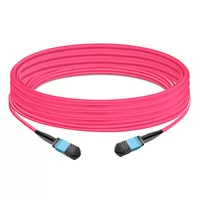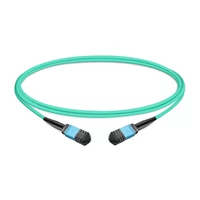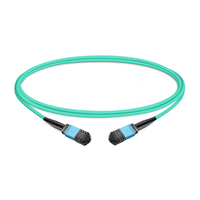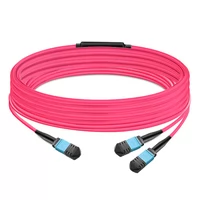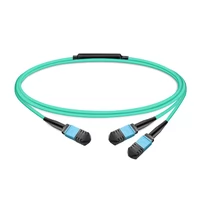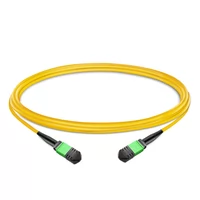At the forefront of innovation, Nvidia MPO cables are in today’s ever-changing world of telecommunications and data center networking. They promise a significant boost for fiber networks in terms of capacity, efficiency, and scalability this paper seeks to assess the various possibilities offered by these advanced cabling solutions with respect to high-speed data transmission and supporting more demanding applications. By concentrating on an exhaustive examination of the technical aspects of MPO technology as it relates to Nvidia’s network gear, we will outline ways through which modern data centers and telecoms infrastructures are likely to be changed by these cables. We also aim to show how essential it is that companies adopt Nvidia MPO cables due to their advantages, such as reducing cost, minimizing space footprint, and increasing throughput and reliability, among others, thus making them ready for future-proofing networks.
Table of Contents
ToggleExploring Nvidia MPO Cable Product Features
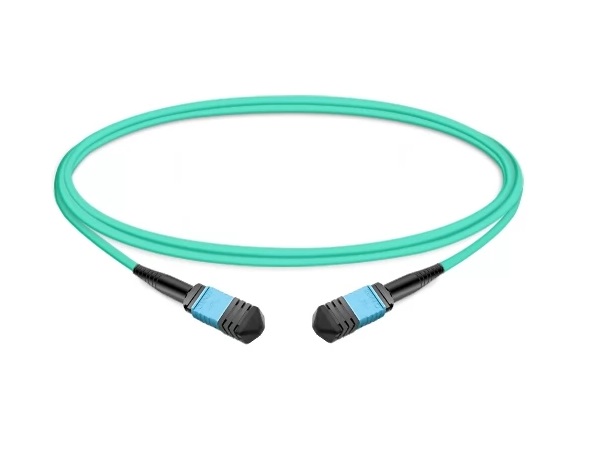
What makes Nvidia MPO cables a fiber optic game-changer?
There are several reasons why Nvidia MPO cables represent a paradigm shift in fiber optic communication.
Firstly, their design features multiple fibers within one connector that significantly increases the cable’s data capacity over traditional single-fiber cables by enabling simultaneous data transmission across different fibers. This multitude not only raises bandwidth but also reduces the physical space required for cables, which is an important advantage in densely packed data centers.
Moreover, Nvidia implements MPO technology with highly precise alignment mechanism that ensures secure and accurate connection reducing loss and enhancing signal integrity.
In addition, the scalability of MPO cables matches up well with emerging network infrastructures that require flexible solutions that can be upgraded or expanded without major redesigns. In other words, Nvidia MPO cables bring about an unprecedented level of efficiency and scalability in building fiber networks’ architecture as never seen before.
Compatibility of Nvidia MPO cables with current fiber networks
Nvidia MPO cables have been designed with a futuristic approach to ensure they are broad in their compatibility with existing fiber network infrastructures. This compatibility is based on a number of key aspects.
Physical Connectivity: Using standardized multi-fiber push-on (MPO) connectors such as those prevalent in present and developing network infrastructures means that Nvidia MPO cables can be integrated into existing MPO-based systems without complex adapters or major reconfigurations necessary.
Optical Performance: Compatible with single-mode and multimode fiber types, the cables support a variety of optical network standards. Hence, they can be applied in various uses ranging from short reaches inside data centers to long distance telecommunication links.
Data Rate Flexibility: These Nvidia MPO cables have a high data rate capacity that supports both current network speeds and future upgrades. As such, no matter the capacity at which the network is operating currently, either 40G, 100G, or higher, the cables will handle their bandwidth requirements, making them suitable for long-term deployments.
Scalability and Modular Design: The modular design of Nvidia MPO makes them easily adaptable to changing needs within a network system. Regardless of whether it’s increasing capacity, extending reach or migrating to new protocols, adjustments can be made incrementally without necessarily having to overhaul the entire system.
Standards Compliance: Nvidia ensures its MPO cables adhere to industry guidelines such as IEEE 802.3 for Ethernet and ANSI/TIA for telecommunications. This enables them to fit in different environments without any compatibility problems.
These features make it possible for Nvidia MPO cables not only to meet today’s optical fiber networks’ requirements but also anticipate what tomorrow holds leading into highly compatible structures and future proofing of networks.
The Role of APC and MMF in Enhancing Nvidia MPO Cable Performance
The performance of Nvidia MPO cables is heavily influenced by two principal components: Angled Physical Contact (APC) and Multimode Fiber (MMF), which are aimed at improved data transmission efficiency and network reliability in general.
1. Angled Physical Contact (APC): The term APC Design refers to the fiber end-face being polished at an angle, typically 8 degrees, in order to reduce back reflection or Optical Return Loss(ORL). This angled polish is important for a number of reasons:
• Minimized Signal Loss: By angling the end face, light that reflects off the connector does not go straight back into the fiber core. Back reflections significantly diminished, thereby inhibiting signal quality degradation.
• Enhanced Signal Quality: Lower ORL leads to a cleaner signal, which is particularly important in high-speed and long-distance applications. This results in improved data integrity and transmission quality.
• Compatibility with High-Speed Networks: For systems operating at 100G or beyond, APC connectors are essential to maintain the signal integrity required for such high data rates.
2. Multimode Fiber (MMF): This type of fiber can transmit multiple light modes concurrently, and therefore, it has some advantages for certain uses:
• Short-Distance Efficiency: MMF offers greater capacity than single-mode fiber and is cheaper for use in short-reach, high bandwidth connections within data centers or enterprise networks.
• Support for High Data Rates: MMF can support different data rates thus making it suitable for various network needs; e.g., 40G and 100G Ethernet applications.
• Flexibility in Deployment: MMF’s mode of operation means that it can accommodate changes in network architecture or data rate requirements without requiring a completely new system.
The inclusion of APCs, as well as MMFs, into Nvidia MPO cables overcomes specific difficulties associated with network connections. Both APC’s ability to minimize back reflection and MMF’s suitability for high bandwidth, short distance applications make these cables capable of meeting the challenging demands of present-day optical networks. While providing a mix of performance, flexibility and reliability, this means that they are not just functional but efficient as well.
Why Nvidia MPO Cables are Essential for High-Speed Network Connections
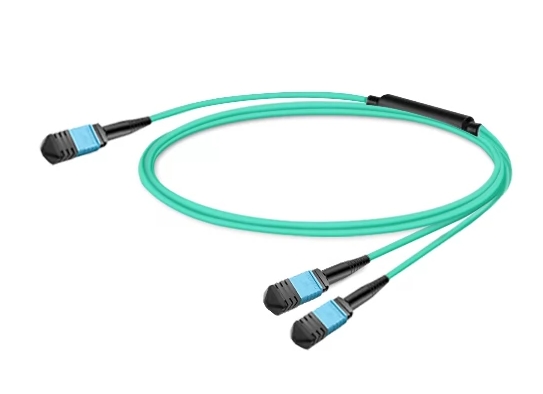
The Advantage of Using Multimode and Single-Mode Nvidia MPO Cables for Data Centers
The Nvidia MPO cables, which come in both single-mode (SMF) and multimode (MMF) formats, are designed to address the complex needs of modern data centers.
- Multimode Nvidia MPO Cables: MMF is particularly adept at handling high-speed data transmissions over shorter distances. This is mainly because it carries many light modes, which increases the bandwidth. Such cables from Nvidia that use OM3 or OM4 fiber types are specifically optimized for these environments so that they can deliver a number of notable benefits, such as:
- High Data Throughput: Can support up to 100Gbps data rates within 100 meters distance.
- Cost-Effectiveness: Generally, MMF solutions, together with their optics, are less expensive than SMFs.
- Ease of Upgrade: MMF can handle alterations without extensive rewiring or replacing hardware components, thereby making it easy for data centers to scale their network architecture.
- Single-Mode Nvidia MPO Cables: SMF excels in long-distance transmissions exceeding MMFs 100-meter limitation. The single-mode variant ensures minimal signal loss and interference over distances, making it ideal for connecting across different data center locations or within extensively large facilities. The key advantages include:
- Long-Distance Efficiency: Perfect for applications requiring data transmission over long distances without significant loss of signal integrity.
- Higher Speed Capacities: Due to its narrower diameter, allowing only a single light mode to propagate, SMF can facilitate much higher data rates over longer distances.
- Future-Proofing: Given that it offers minimal physical infrastructure change along with adaptability towards technology updates and advancements, SMFs could be considered more future-proofed.
Understanding the Speed and Performance Benefits of OM3 Fiber with Nvidia MPO Cables
OM3 fiber is a variant of multimode fiber that has been specifically designed for high-speed data transmission. When using Nvidia MPO cables, OM3 fiber offers the following:
- Optimized Bandwidth: Optimized for 10Gbps data rates and can support up to 100Gbps at shorter distances. This makes OM3 fiber an attractive choice in high-density, high-bandwidth settings.
- Laser-Optimized Performance: It is designed specifically to work with VCSEL (Vertical-Cavity Surface-Emitting Laser) technology making it more efficient and less power consuming than other optic fibers.
- Extended Reach: This type of optic fibers can transmit 10Gbps data over a distance of 300meters and 40/100Gbps over a distance of 100meters, which means they are suitable for most in-building or intra-campus networking applications.
Direct Attach Copper (DAC) vs. Passive Optical Nvidia MPO Cables: A Comparison
- Direct Attach Copper (DAC) Cables:
- Cost efficiency: Normally, DAC cables are cheaper than optical alternatives for short-distance links.
- Lower latency: For the `time critical’ applications, DAC has a little bit lower latency with the direct electrical connection.
- Ease of use: DAC is easy to work with because it plugs directly into devices without any need for additional transceivers.
- Passive Optical Nvidia MPO Cables:
- Distance Benefits: Can cover more ground without the need for active equipment, which is useful in large data center campuses.
- Greater Bandwidth Capacity: Optical cables provide a larger bandwidth that leads to higher data rates over long distances.
- Flexibility and Scalability: By allowing multiple fibers to be terminated on a single interface, MPO connectors enhance the cabling density and scalability of data center architectures.
In summary, the decision to go for either DAC or passive optical MPO cables depends heavily on the data center’s specific requirements, such as distance, cost, and scalability needs.
Finding the Right Nvidia MPO Cable for Your System

How to Select the Correct Nvidia MPO Cable Length and Type for Your Network
To ensure that the network is running at its best, it is important to choose the right Nvidia MPO cable length and type. These are the key factors to consider:
Measure the exact distance between devices to be connected – This will help in choosing a cable length that closely matches this measurement so as not to lose signal or need extra cable management.
Determine your network’s speed and bandwidth requirements – For 10Gbps applications, OM3 and OM4 cables are enough, while OM5 cables may be necessary for higher speeds like 40/100Gbps
Consider the physical layout of your data center or network environment – Specific cable types, such as those with bend-insensitive fiber, may be required due to tight bends or longer runs.
The Significance of Choosing LSZH Nvidia MPO Cables for Safer Installations
Critical for safe installations in places with little space or insufficient ventilation, the Low Smoke Zero Halogen (LSZH) Nvidia MPO cables are of much importance. The advantages of these LSZH cables include:
- Less Poisonous: During fires, they discharge fewer amounts of toxic gases and corrosive fumes as opposed on conventional PVC or halogenated materials.
- Better Personnel and Equipment Safety: LSZH wires reduce smoke and corrosive gas emissions, thereby improving people’s visibility during evacuation and reducing damage to delicate electronic machinery.
- Adherence to safety laws: In public buildings and highly populated areas, many jurisdictions require that LSZH materials be used for fire prevention purposes.
Distinguishing Between QSFP56 and QSFP112 Options in Nvidia MPO Cables
Form factors for pluggable transceivers and direct attach cables are QSFP56 and QSFP112, differentiated mainly by the data rates they support:
- QSFP56: Designed for 200Gbps applications, a link of 50 Gbps per channel on 4 channels can be provided by QSFP56. It is compatible with earlier versions of QSFP form factor (i.e., QSFP+, QSFP28) but at higher speeds that are suitable to forward-looking data centers.
- QSFP112: Targeted at 400Gbps connectivity, channel capacity in the case of QSFP112 is twice more than that in the case of QSFP56 with a provision of 100 Gbps per channel over four channels. This option is best suited for high bandwidth requirements found in large-scale data centers and HPC environments.
It’s important to consider distance, network requirements, safety standards and future needs when choosing an Nvidia MPO cable. You will provide a solidly reliable; efficient and safe network installation if you know these parameters.
A Comprehensive View on the Quality and Cost of Nvidia MPO Cables
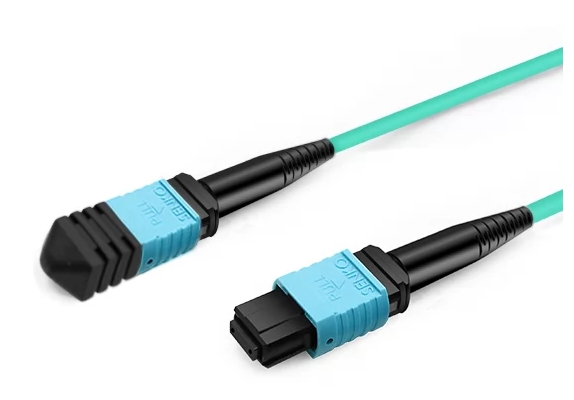
Evaluating the Quality and Durability of Nvidia’s Fiber Optic Networks
Nvidia’s MPO cables’ quality and strength are essential for fiber optic network efficiency and performance. These MPO cables with high-strength optical fibers enable low insertion losses and great signal integrity, thereby ensuring reliable transmission of high-speed data. Further durability is achieved by the LSZH (Low Smoke Zero Halogen) jacketing, which provides an extra defense against environmental factors and physical wear. Durability considerations include:
- Fiber Quality: Premium optical fibers in use have superior light transmission characteristics.
- Jacket Material: Improved cable life span with LSZH materials to ensure user safety.
- Connector Design: Minimized insertion loss through highly precise connectors to have well-established connections.
Breaking Down the Cost-Benefit Analysis of Investing in High-Quality Nvidia MPO Cables
There are various long-term benefits that justify the initial costs of investing in superior Nvidia MPO cables. They include:
- Reduced Network Downtime: These high-quality cables have fewer faults leading to less downtime and its associated expenses.
- Enhanced Data Speed and Integrity: This guarantees the highest possible data transmission speeds, reliability which is very important for high-performance computing environments.
- Future-Proofing: These are future scalable networks as they support higher data rates like 400Gbps for QSFP112.
In terms of cost, factors to consider include their buying price, potential savings on maintenance and downtime plus long term scalability considerations.
Guarantee and Customer Service: Shop Nvidia MPO Cables with Confidence
The MPO cable products of Nvidia come with warranties and customer support services to instill confidence in the customers. Key aspects include:
- Product Warranty: As such, Nvidia offers a standard guarantee for product quality as well as defects from materials or craftsmanship that may necessitate prompt attention within the warranty period.
- Customer Support: Technical support is available to deal with troubleshooting, installation inquiries, and even network optimization.
- Quality Assurance: Every cable goes through stringent testing processes before being declared fit according to Nvidia’s performance standards and dependability.
In conclusion, Nvidia’s fiber optic networks are known for their top-notch quality and resilience due to modern technology utilization and superior component selection. The cost of investing in these high-quality cables is balanced by the benefits of reduced downtime, enhanced data transmission, and future-readiness. Alongside robust warranty and support systems for clients, this therefore makes them a viable investment towards solidifying strong and efficient fiber optic networks using Nvidia MPO cables.
Enhancing Your Network’s Performance with Nvidia MPO Cables
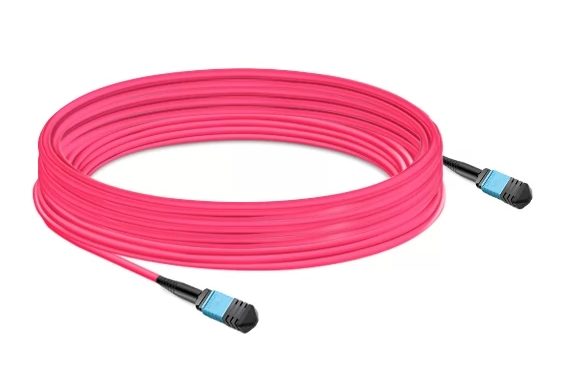
The exploration of Nvidia MPO cables can improve your network’s data throughput and latency, making it possible to have optimal performance in today’s data heavy environment. Additionally, here is how the Nvidia MPO cables can be integrated into existing storage systems, as well as a look at how these cables are going to influence digital communication in the future.
Leveraging Nvidia MPO Cables for Improved Data Throughput and Latency
- Upgrade Planning: Appraise the current network infrastructure in order to identify points at which data flows get choked. By installing Nvidia MPO cables at these chokepoints, it would be possible to ensure high-speed data flow and avoid transmission delays.
- Compatibility Check: You need to ascertain that the old-fashioned equipment like transceivers, connectors, switches, and others can work with Nvidia MPO cables (such as 400Gbps for QSFP112). This is what should be done in order to enable users to have the maximum yield from these cables.
- Seamless Integration: The introduction of Nvidia MPO cables into your network can be achieved through a phased approach. There are limited disruptions during this process, which allows great improvements in actual performance tests.
Strategies for Integrating Nvidia MPO Cables into Existing Storage Systems
- High-Connection Density: The cables of Nvidia MPO have very high connection density, which makes them best for use in storage area networks (SANs) that demand space and efficiency. The inclusion of such cables can greatly increase connectivity in a limited space.
- Optimizing Data Centers: The replacement of the old cables with Nvidia MPO cables would lead to higher speed interconnects in data centers. This improvement is critical for storage systems that need rapid access to large amounts of data.
- Futuristic Storage Infrastructure: One must have a network capable of supporting increasing data traffic when it comes to storage needs as they grow. With the scalability aspects of Nvidia MPO cables, your storage system will be able to handle future growth in information efficiently.
The Future of Digital Communication and Nvidia MPO Cables
The digital communication environment is currently shifting at a high speed with the need for faster data transmission rates, lower latency, and better reliability. Nvidia MPO cables play a leading role in this process. Here are some of their advantages:
- Higher Data Rates: Nvidia MPO cables providing 400Gbps support will enable future applications such as AI, big data analytics, and 5G networks to cater for increasing volumes of data.
- Less Latency: Real-time applications, online gaming, and financial transactions depend on low-latency networks. Transmission delays can be significantly reduced by using Nvidia MPO cables thereby boosting user experience and operational efficiency.
- More Reliable: The strong construction features and tests carried out on the quality of these cables guarantee that they have a high level of reliability, which minimizes downtime and maintenance costs.
To sum up, today’s businesses can rely on Nvidia MPO cables both in terms of current and future network needs so that they can keep pace with the ever changing digital scenario. By strategically adding these cables into your present infrastructure you could improve your system’s performance greatly towards tomorrow’s digital communication needs.
Navigating the Market: How to Order and Access Nvidia MPO Cables
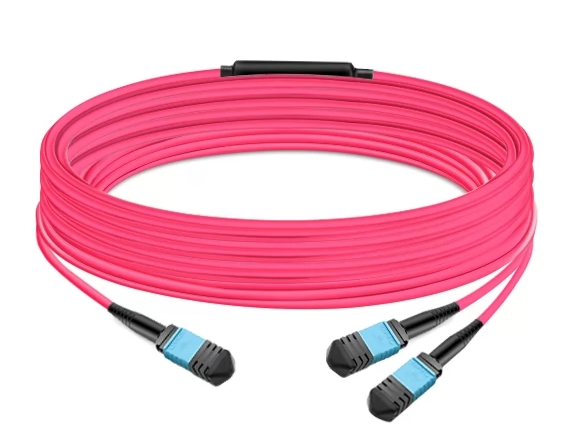
You will need to be very careful if you want to find Nvidia MPO cables that are available and ready for shipping. You should get in touch with reputable distributors and dealers of specialized networking equipment who always have the latest inventories, which can as well be shipped immediately. It is important to ensure that Nvidia MPO cables are compatible with your current network infrastructure before you place an order. Hence, verify the cable features against your devices’ specifications by looking at them. Also, check out on the connector types, cable length, and bandwidth capacity.
Please note that if you require assistance with Nvidia MPO cabling options or configurations – contact customer support: this would be a reasonable decision for any user. Many well-known suppliers offer technical support where you can seek advice from professionals who will consider all the peculiarities of your particular network setup. When contacting them, summarize your current network configuration and requirements. This will enable the support team to provide recommendations that are most precise and beneficial to you. Remember that spending some time on research and even consulting may greatly improve the performance as well as the dependability of your network infrastructure.
Reference sources
- Nvidia Official Website – Product DocumentationNvidia’s official website offers all-inclusive product documentation on its MPO cables, including features, compatibility, and applicability in fiber optic networks. This is a useful source for professionals wishing to get accurate information from the manufacturer, which will enable them to properly understand the capacity of Nvidia MPO cables that are used in upgraded fiber networks.
- IEEE Xplore Digital Library – Research on MPO Cable Applications in High-Speed NetworksAn IEEE Xplore Digital Library peer-reviewed article presents a study of MPO cables, including those by Nvidia, in high-speed fiber optic networks. The research presents technical advances, performance measures, and comparisons with other connectivity options to provide academic insight into how Nvidia MPO cables are transforming the evolution of fiber optic infrastructure.
- Fiber Optic Tech Magazine – Guide to MPO Cables in Data CentersFiber Optic Tech Magazine’s article is a guide to using MPO cables, including those offered by Nvidia, in today’s data centers. It discusses the best ways to select the right MPO cables for a network and install them to ensure they work properly. This publication’s target audience includes industry players interested in successfully deploying Nvidia MPO cables inside future fiber network configurations.
Frequently Asked Questions (FAQs)
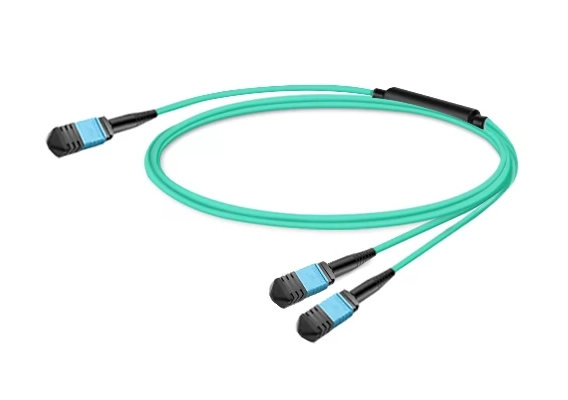
Q: Why are Nvidia MPO network cables important in fiber networks?
A: The importance of this lies on those cables being able to increase capacity and speed of fiber networks. The reason is that Nvidia MPO network cables are made specifically for low-latency, high-bandwidth applications enabling next-gen networks through support of infiniband and high-speed ethernet with their multi-mode fiber capacities.
Q: Are all Nvidia MPO fiber cables compatible with existing network infrastructure?
A: Most Nvidia MPO fiber cable products are designed to be backward compatible with existing network infrastructure. Nonetheless, it is important to check the specific features such as single mode or multi-mode and connector types like osfp or mpo-12 to establish if they meet your current setup’s requirements.
Q: What is the maximum length available for Nvidia MPO fiber cables for a 30m requirement?
A: There will usually be various lengths of Nvidia MPO fiber cables including one at thirty meters which is often common in applications that need longer cable runs without compromising signal quality; thus, make sure you review the product description concerning exact length for your network needs.
Q: How does one ensure buying a genuine Nvidia MPO fiber cable item?
A: To buy an original product purchase from reputable stores or directly from manufacturer websites. Check product descriptions that mention genuine Nvidia MPO fibers and also stock availability while shopping confidently from stores offering authenticity guarantees on their products.
Q: What are Nvidia MPO cables suited for?
A: Nvidia MPO cables work best for high-speed fiber networks that require a lot of bandwidth and low latency like infiniband and ethernet protocols. They can be used in data center interconnects, enterprise networking, and high performance computing environments.
Q: Is it possible to use Nvidia MPO cables with directly attached copper cable connections?
A: Some types of Nvidia MPO cabling can support otherwise direct attach copper cabling needed especially where fibre is preferred for distances beyond the reach of passive copper which usually has a limitation of 7 meters. Check the particular product description to ascertain this feature.
Q: What if the Nvidia MPO cable I need is out of stock?
A: It’s important to check with the store’s customer service department to see where you want to order your Nvidia MPO cable or wait, as they may have some information on when they could get more stock or even place a backorder. Alternatively, availability might be confirmed by making inquiries from several reputable vendors or going directly to manufacturers.
Q: Are there any special considerations when dealing with the production and handling of these types of cables?
A: UL certifications for safety and performance, including strict quality control standards, must be adhered to during production and handling processes for Nvidia MPO cables. To avoid hampering proper functioning, care should be taken while handling these cables so as not to damage either the connectors or fibers themselves.
Q: How do I confidently shop for international delivery NIVIDIA MP0 Cables?
A: When shopping around for international delivery-friendly options for NIVIDIA MP0 Cables, look for stores that have explicit international shipping policies, including customs duties details and reliable tracking. Further, read customer reviews and ascertain their return policy terms to make an easy purchase. You can also contact us at any time, it is our responsibility to provide you with professional advice and technical support.
Related Products:
-
 NVIDIA MFP7E10-N035 Compatible 35m (115ft) 8 Fibers Low Insertion Loss Female to Female MPO Trunk Cable Polarity B APC to APC LSZH Multimode OM4 50/125
$118.00
NVIDIA MFP7E10-N035 Compatible 35m (115ft) 8 Fibers Low Insertion Loss Female to Female MPO Trunk Cable Polarity B APC to APC LSZH Multimode OM4 50/125
$118.00
-
 NVIDIA MFP7E10-N003 Compatible 3m (10ft) 8 Fibers Low Insertion Loss Female to Female MPO Trunk Cable Polarity B APC to APC LSZH Multimode OM3 50/125
$35.00
NVIDIA MFP7E10-N003 Compatible 3m (10ft) 8 Fibers Low Insertion Loss Female to Female MPO Trunk Cable Polarity B APC to APC LSZH Multimode OM3 50/125
$35.00
-
 NVIDIA MFP7E10-N005 Compatible 5m (16ft) 8 Fibers Low Insertion Loss Female to Female MPO Trunk Cable Polarity B APC to APC LSZH Multimode OM3 50/125
$38.00
NVIDIA MFP7E10-N005 Compatible 5m (16ft) 8 Fibers Low Insertion Loss Female to Female MPO Trunk Cable Polarity B APC to APC LSZH Multimode OM3 50/125
$38.00
-
 NVIDIA MFP7E20-N050 Compatible 50m (164ft) 8 Fibers Low Insertion Loss Female to Female MPO12 to 2xMPO12 Polarity B APC to APC LSZH Multimode OM4 50/125
$145.00
NVIDIA MFP7E20-N050 Compatible 50m (164ft) 8 Fibers Low Insertion Loss Female to Female MPO12 to 2xMPO12 Polarity B APC to APC LSZH Multimode OM4 50/125
$145.00
-
 NVIDIA MFP7E20-N003 Compatible 3m (10ft) 8 Fibers Low Insertion Loss Female to Female MPO12 to 2xMPO12 Polarity B APC to APC LSZH Multimode OM3 50/125
$52.00
NVIDIA MFP7E20-N003 Compatible 3m (10ft) 8 Fibers Low Insertion Loss Female to Female MPO12 to 2xMPO12 Polarity B APC to APC LSZH Multimode OM3 50/125
$52.00
-
 NVIDIA MFP7E30-N003 Compatible 3m (10ft) 8 Fibers Low Insertion Loss Female to Female MPO Trunk Cable Polarity B APC to APC LSZH Single-Mode OS2 9/125
$42.00
NVIDIA MFP7E30-N003 Compatible 3m (10ft) 8 Fibers Low Insertion Loss Female to Female MPO Trunk Cable Polarity B APC to APC LSZH Single-Mode OS2 9/125
$42.00

